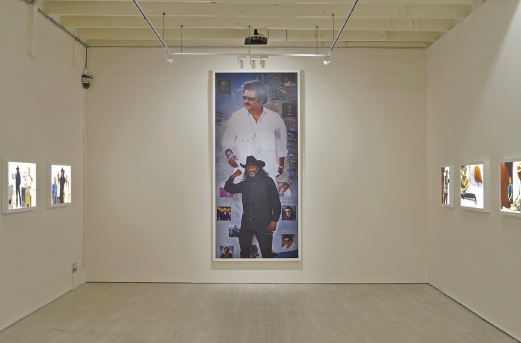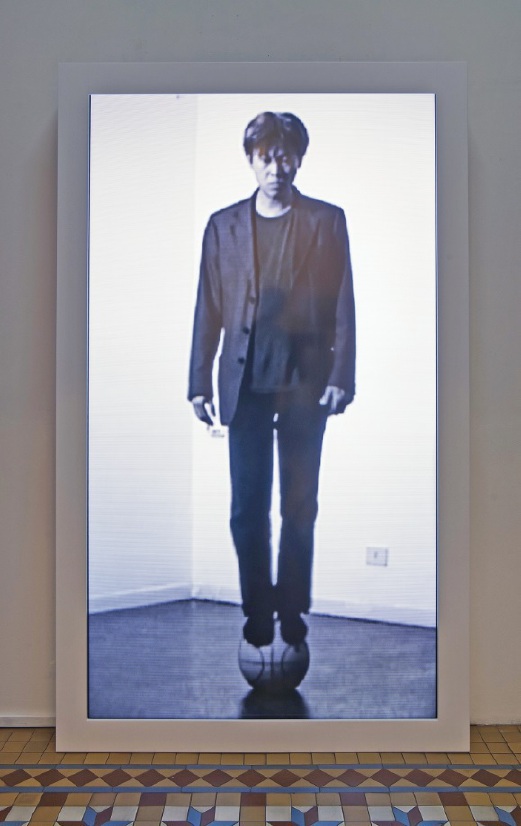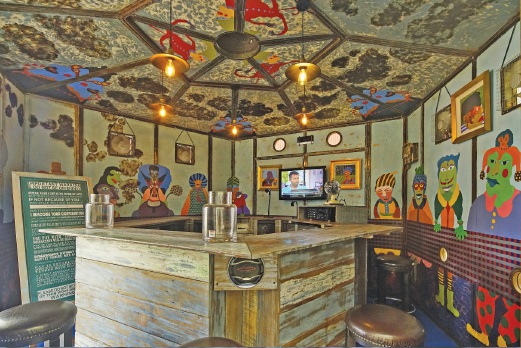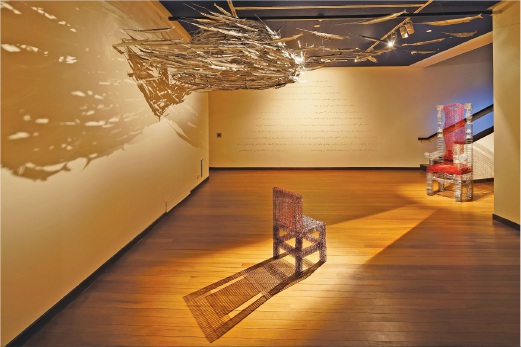At the Singapore Biennale, the pairing of atlas and mirror characterises the way we observe the world, writes Sarah NH Vogeler
BIENNALES is tough business, the competition mad. There are over a hundred held worldwide and the number is increasing. For places that hold them, biennales have emerged as pivotal cradles of cultural pride, international acknowledgement and tourism. Every place competes war-like, for superstar curators and artists, the latter “hired” to conjure over-the-top works and installations, resulting in shows which are overwhelmingly mounted, extravagantly fashioned and swinging towards the almighty. Regular biennale attendees expect nothing less. As each installation and work becomes bigger, they become more forgettable. You sort of remember the pomp but are unsure of its purpose.
Well, not all. The Singapore Biennale, held at the Singapore Art Museum (SAM) and in its fifth run, has several “must sees”, works which permit the mind to open and have more cognizance to observe the world in alternate ways. We look at some of our own artists participating in this year’s edition.
LIFE OR SOMETHING LIKE IT
Azizan Paiman’s Putar Alam Cafe is meticulously structured. You can see that the organisers were that perfect sounding board, ensuring the artist’s idea is thoroughly developed and providing him with solid support both curatorial and material wise. Paiman even had to take a course on food preparation for this purpose.
Assembled as a pop-up snack bar, Putar Alam Cafe is entertaining and quirky, theoretical and complex. How do we affect change? Perhaps it can begin from the smallest of conversations, as Paiman explains: “Putar Alam Cafe is a space which allow patrons to congregate in one place, and talk about almost anything: Politics, economics, social life, religion and culture of the modern world.”
Paiman as moderator/ bartender/ food server, never claims that his little soirees will solve anything, but rather creates a safe haven for these topics to be debated upon. In the background are collages of his past works, characters which sit as silent observers, intently watching each customer vent and lament.
Sharmiza Abu Hassan’s The Covenant is another interesting entry. Curatorial co-head Tan Siuli summarises: “The chronicles and tales in the Sejarah Melayu (the Malay Annals, originally titled Sulalatus Salatin (Geneology Of Kings), c. 15th-16th centuries) have been hugely influential on not only the literature, but also the history, culture, civilisational development and identity construction of the Malay people. For the artist, this literary work has been a rich source of ideas, inspiration and images for her art practice, as well as her effort to re-assess certain traditional Malay values and cultural practices via contemporary readings and representations of these mytho-historical narratives.”
Elaborate Jawi writings adorn one wall, symbolising the grave vow between Sang Suparba (the supposed forefather of Malay Sultans) and the leader of his Malay subjects, Demang Lebar. A steel wire mesh/ metal plate throne and a miniscule chair sit unobtrusively on the floor facing one another — representing the sovereign and his subjects. The ceiling is gilded with aluminium swordfish. Because of its revolving arrangement, these sea creatures appear alive, swimming around the room in hypnotic loops. The Covenant is pure theatre: The story of a sacred oath shattered and a world forever altered.
From Kedah-born H.H. Lim we get the two channel video works Enter The Parallel World, and the first things you see upon entering SAM. Titled About 60 kilos Of Wisdom and The Falling Wisdom, we see in the first film, the artist precariously balancing on a basketball, which he triumphed at for a marvellous 30 minutes, and in the second flick, Lim slips and falls. “I was completely dedicated in preparing for 60 kilos, which was intense training to be both physically and mentally ready. Self-control and consistent workouts are crucial for seeking new solutions, no matter the weight that falls.”
The paired videos of Enter The Parallel World is the artist’s exploration of the veracities of corporeal parameters, and that it takes many, many failed attempts before victory can be savoured. And maybe because we are all closeted hedonists, some parts of us wanted to see him crumble and spill into the ground, and applauded gleefully when he did exactly that.
Ahmad Fuad Osman’s Enrique de Malacca Memorial Project is a homage to Enrique Of Malacca, also known as Henry the Black or Panglima Awang, whom in some accounts, was the first person to go around the world. In the 1957 historical novel Panglima Awang written by Malaysian writer Harun Aminurrasyid, he perceived Enrique as a Malayan and not Indonesian Malay, and it is within this narrative which Fuad created his mixed-media installation — an analysis of the unending yet ineffectual sociocultural and geopolitical affrays between the nation states of Southeast Asia.
EYES WIDE OPEN
There is much more to see and absorb. Niranjan Rajah’s three-part installation Koboi Balik Lagi (the Cowboy Returns Home), the artist’s alter ego posing against Tamil superstar Rajinikanth in Kedualan si Koboi (The duality of the Koboi) and in the other, PujaanKu (One and Only) is quite something else. Multidisciplinary conceptual artist Tan Zi Hao’s The Skeleton of Makara (The Myth of a Myth) a massive fossilised skeleton-replica of the makara made of fibre glass is in one word, stunning. And Chia Chuyia’s durational performance piece Knitting the Future was first shown at last year’s Venice Biennale. Her gruelling knitting session, taking place in a darkened space and using shredded leek is done over a period of a month, six days a week for six hours at a stretch, and will become a full length gown to be displayed from the top of the gallery’s ceiling.
There were plenty of works in An Atlas of Mirrors which inspire awe in varying degrees, and all 58 stands out from their own unique standpoints. Praise for the SAM curatorial team, creative director Dr Susie Lingham, assistant curators Andrea Fam and John Tung, associate curators Michael Lee, Suman Gopinath, Nur Hanim Kamaruddin and Xiang Liping, curatorial co-heads Joyce Toh and Tan Siuli and curator Louis Ho for their inspiring vision, and putting together what must have been a back-breaking, mind-twisting journey.
And whether on purpose or purely coincidental, the ‘awe-ness’ was extended to a particular member of the curatorial team, the iridescent nymph with the coiffure and attire so edgy it would make Tom Ford do a handstand. It is spectacular performance-art, and with enough high-art cred to equal and at times surpass the works on show. We like this idea very much, that every once in a while amidst a score of expected things, something really exquisite comes floating by and blows the mind.
From Leonard Cohen’s final album, You Want It Darker, we continue to pray for magic to come, in whatever form:-
If you are the dealer, I’m out of the game
If you are the healer, it means I’m broken and lame
If thine is the glory, then mine must be the shame
You want it darker
We kill the flame
Singapore Biennale — An Atlas of Mirrors
When Until 26 Feb
Where Singapore Art Museum
71 Bras Basah Road
Singapore
(65) 6589 9580
Nine conceptual zones
IN Dr Susie Lingham’s writings, she indicated that the main title of the biennale is woven through nine conceptual zones which locate each artwork in particular curatorial contexts. Artworks located within each zone resonate on many levels and at the same time, all zones coincide, intertwine and reflect each other along the conceptual continuum of “An Atlas of Mirrors” as a whole. The nine zones are An Everywhere of Mirrorings, An Endless of Beginnings, A Presence of Pasts, A Culture of Nature, A Share of Borders, A Breath of Wills, A Flow of Identities, A Somewhere of Elsewheres and A Past of Absences.
The Singapore Art Museum (SAM) is a contemporary art museum which focuses on art-making and art-thinking in Singapore, Southeast Asia and Asia, encompassing a world-wide perspective on contemporary art practice. Opened in 1996, SAM has amassed one of the most important collections of contemporary art from the region, seeking to seed and nourish a stimulating and creative space in Singapore through exhibitions and public programmes, and to deepen every visitor’s experience. In 2011, SAM was the venue manager of the Singapore Biennale, becoming the main organiser of the 2013 and 2016 editions.






